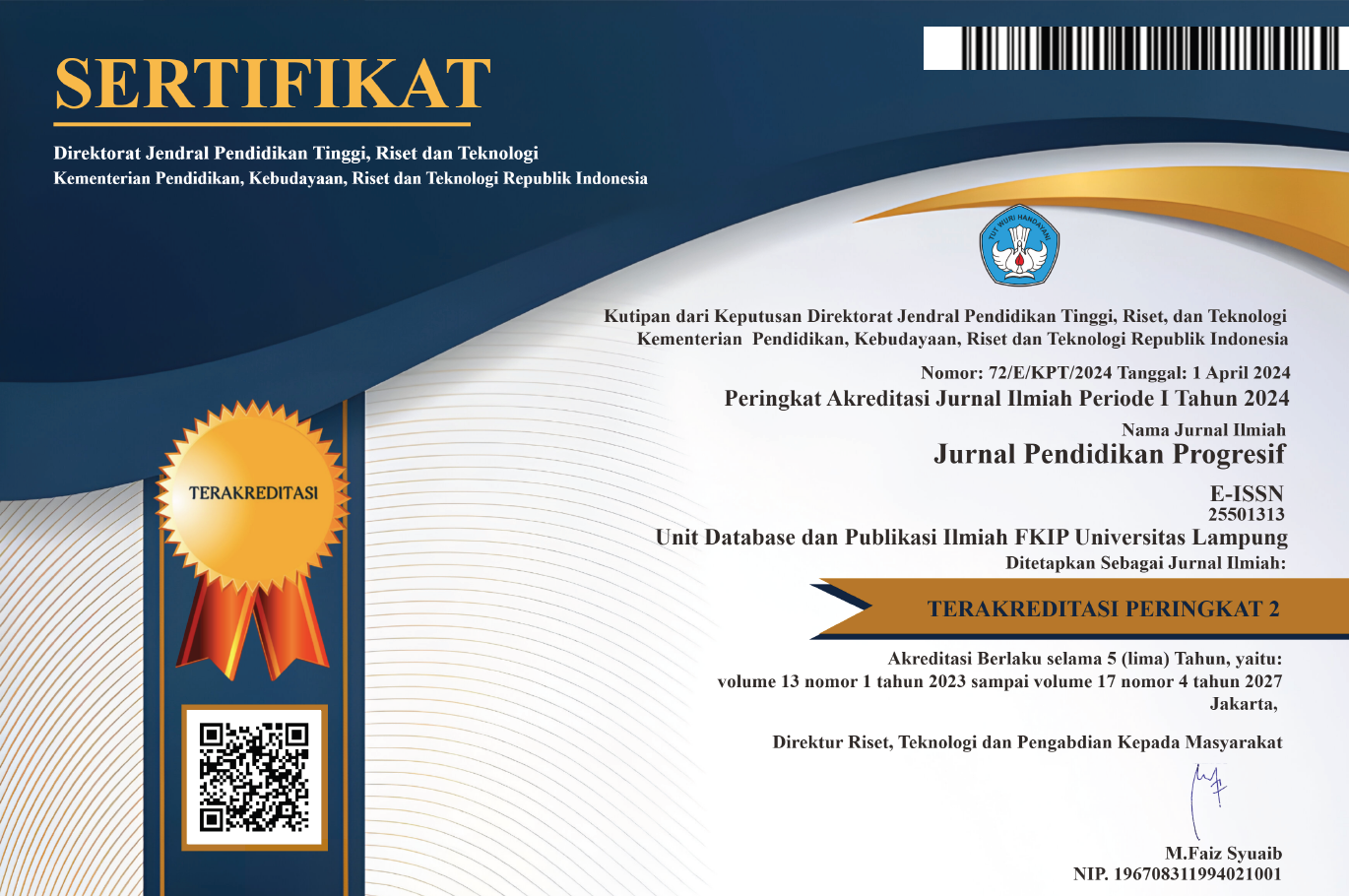Evaluation of Blended Learning Implementation in Faculty of Teacher Training and Education, Universitas Lampung
| Metrics→ |
| Indexing Site→ |
Copyright (c) 2025 Sowiyah Sowiyah
Evaluation of Blended Learning Implementation in Faculty of Teacher Training and Education, Universitas Lampung. Objectives: This study aims to evaluate the implementation of an online blended learning namely Edusmart as a support for face-to-face lectures at the Faculty of Teacher Training and Education, Universitas Lampung (FKIP UNILA). Methods: This study used a qualitative descriptive research method using three instruments, namely the observation guidelines, interviews and questionnaires. The subjects in this study were lecturers, students and helpdesk admin in FKIP UNILA. Data were collected in accordance with the object of research, namely to describe the implementation of blended learning through observation, interviews and questionnaires related to the responses of lecturers and students. Findings: The results showed that the implementation of blended learning had a positive impact and received good responses from lecturers and students. Students and lecturers are actively involved in learning activities, both online and face-to-face.
Keywords: evaluation, implementation, blended learning
Akkoyunlu, B., & Soylu, M. Y. (2008). A Study of Student’s Perceptions in a Blended Learning Environment Based on Different Learning Styles. Educational Technology & Society, 11(1), 183-193.
Akkoyunlu, B. & Soylu, M.Y. (2006). A Study on Students’ Views about Blended Learning Environment. Turkish Online Journal of Distance Education-TOJDE, 7(3).
Ali, W. (2020). Online and Remote Learning in Higher Education Institutes: A Necessity in light of Covid-19 Pandemic. Higher Education, 10(3).
Altheide, D. L. & Johnson, J. M. (1994). Criteria for assessing interpretive validity in qualitative research. In N. K. Denzin & Y. S. Lincoln (Eds.), Handbook of qualitative research (pp. 485-499). Thousand Oaks, CA: Sage.
Bath, D., & Bourke, J. (2010). Getting Started with Blended Learning. Griffith Institute for Higher Education: QueensLand.
Bétrancourt, M., & Tversky, B. (2000). Effect of computer animation on users’ performance: A review. Le Travail Humain, 63(4), 311-330.
Bonkand, C. J., & Graham, C. R. (2006). Part One: Introduction to Blended Learning, in Handbook of Blended Learning: Global Perspectives, Local Designs, B. Miller, Ed. San Francisco: Pfeiffer & Company, 2006, pp. 1-385.
Demirci, N. (2010). Web-Based vs. Paper-Based Homework to Evaluate Students’ Performance in Introductory Physics Courses and Students’ Perceptions: Two Years’ Experience. International Journal on E-Learning, 9(1), 27-49.
Donnelly, R., & Mc Sweeney, F. (2009). Applied E-Learning and E-Teaching in Higher Education. Information Science Reference. Hersey: New York.
Dziuban, C.D., Hartman, J.L., & Moskal, P.D. (2004). Blended Learning. Internet, 7, 1-44.
Werth, E. L & Kellerer, E. (2013). Transforming K-12 Rural Education through Blended Learning: Barriers and Promising Practices, Int. Assoc. K-12 Online Learn.
Gall, M. D., Borg, W. R., & Gall, J. P. (1996). Educational research: An introduction. White Plains, NY: Longman.
Hameed, S., Badii, A., & Cullen, A. J. (2008). Effective E-Learning Integration with Traditional Learning in a Blended Learning Environment. European and Mediterranean Conference on Information System, May 25-26.
Heinze, A. (2008). Blended Learning: An Interpretive Action Research Study. Disertasi Doctor. University of Salford. Salford: UK.
Jayaprabha, R., & Jayakumari, M. D. (2020). The Best Online Teaching for Covid-19. Purakala with ISSN 0971-2143 is an UGC CARE Journal, 31(24), 178-183.
J. S. Drysdale, C. R. Graham, K.J. Spring, and L. R. Halverson. (2013). Internet and Higher Education: An Analysis of Research Trends in Dissertations and Theses Studying Blended Learning. Internet High. Educ., 17, 90–100.
K.A. Bingimlas. (2009) Barriers to the Successful Integration of ICT in Teaching and Learning Environments: A Review of the Literature. Eurasia J. Math. Sci. Technol. Educ., 5(3), 235–245.
Kitzinger, J. (1995). Qualitative Research: Introducing Focus Group. British Medical Journal, 311, 299-302.
Kusni, M. (2010). Implementasi Sistem Pembelajaran Blended Learning pada Matakuliah AE3121 Getaran Mekanik di Program Aeronotika dan Astronotika. Seminar Tahunan Teknik Mesin.
Lin, E., & Lin, C. H. (2015). The Effect of Teacher-Student Interaction on Students’ Learning Achievement in Online Tutoring Environment. International Journal of Technical Research and Applications, 22(22), 19–22.
Ling, L. H. (2007). Community of Inquiry in an Online Undergraduate Information Technology Course. Journal of Information Technology Education, 6, 153–168.
McMillan, J.H. and Schumacher, S. (2010). Research in education: Evidence-based inquiry. New Jersey: Pearson Education.
M. Sayed and F. Baker. (2014) Blended Learning Barriers: An Investigation, Exposition and Solutions. J. Educ. Pract., 5(6), 81–85.
Moskal, P., Dzubian, C., & Hartman, J. (2013). Blended Learning: A Dangerous Idea? Internet and Higher Education, 18, 15–23.
Murphy, M. P. A. (2020). COVID-19 and Emergency E-Learning: Consequences of the Securitization of Higher Education for Post-Pandemic Pedagogy. Contemporary Security Policy. DOI: 10.1080/13523260.2020.1761749.
Osguthorpe, R. T. & Graha, C. R. (2003). Blended Learning Environments. Q. Rev. Distance Educ., 4(3), 227–233.
Rovai, A. P. & Jordan, H. M. (2004). Blended Learning and Sense of Community: A Comparative Analysis with Traditional and Fully Online Graduate Courses. The International Review of Research in Open and Distance Learning, 5(2).
Sjukur, S.B. (2012). Pengaruh Blended Learning terhadap Motivasi Belajar dan Hasil Belajar Siswa Tingkat SMK. Jurnal Pendidikan Vokasi, 2(3).
Syarif, I. (2012). Pengaruh Model Blended Learning terhadap Motivasi dan Prestasi Belajar Siswa SMK. Jurnal Pendidikan Vokasi, 2(2).
Tichavsky, L. P., Hunt, A., Driscoll, A., & Jicha, K. (2015). "It is Just Nice Having a Real Teacher": Students' Perceptions of Online Versus Face-to-Face Instruction. International Journal for the Scholarship of Teaching and Learning, 9(2). DOI: 10.20429/ijsotl.2015.090202.
Tseng, W. (2014). Effect of Integrating Blended Teaching into Mathematics Learning for Junior High School Students. J. Comput. Appl. Sci. Educ., 1(2), 39–57.
Undang-Undang Nomor 20 Tahun 2003 tentang Sistem Pendidikan Nasional.
Undang-Undang Nomor 44 Tahun 2015 Pasal 14 Tentang Standar Nasional Pendidikan Tinggi.
Vaughan, N. (2007). Perspective on Blended Learning in Higher Education. International Journal on E-Learning, 6(1), 81-94.
Wicaksono, H. (2018). Implementasi Blended Learning (Studi Kasus di STMIK Indonesia Mandiri & STIE-STAN Indonesia Mandiri Bandung). Jurnal Informasi, 10(1), Februari.
Wiersma, W. (1995). Research Methods in Education: An Introduction (6th ed.). Boston: Allyn and Bacon.
Refbacks
- There are currently no refbacks.

This work is licensed under a Creative Commons Attribution-ShareAlike 4.0 International License.
View My Stats



 Country:
Country: